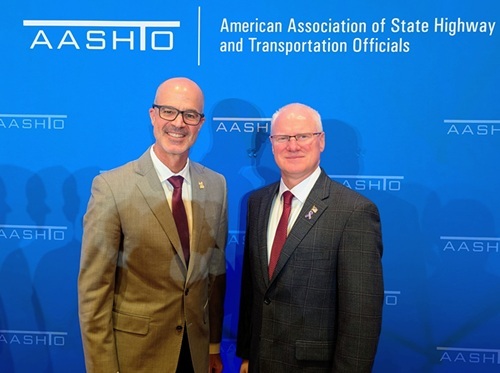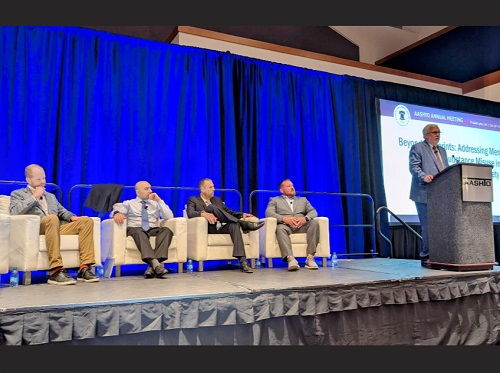A knowledge session at the 2024 American Association of State Highway and Transportation Officials Annual Meeting in Philadelphia discussed some of the stark mental health and substance abuse issues facing today’s construction workforce.
[Above photo by AASHTO]
Sponsored by RS&H –a national architecture, engineering, and consulting firm – the session delved into raising awareness about the growth of those issues among construction workers and what the transportation industry as a whole can do about it.
“Just raising awareness about these issues has become a priority of mine,” noted session moderator Tom Everett; senior vice president with RS&H and former executive director of the Federal Highway Administration.
“This really has become an epidemic in our industry; applying to anyone working in either an office or the field. I have not championed this for very long, but for me, it stems from having experiences with colleagues who suffered from PTSD [Post Traumatic Stress Disorder], extreme anxiety, and successful suicides,” he said – adding that these instances occurred before the COVID-19 pandemic.
“These were people close to me – and there were no warning signs. So I keep asking myself; did I miss something? It made me feel helpless,” Everett explained. “As engineers, we are trained to find solutions. So there is value in talking about this; we have to start somewhere. But that is not enough. We need to get more familiar with our EAPs – employee assistance programs. It is important for leadership to talk about them and to be involved.”
Brandon Anderson, vice president of safety for the Missouri chapter of the Associated General Contractors of America – himself a two-time suicide survivor – noted that overall in the U.S. suicides increased to 49,300 in 2023 – up from 48,183 since just 2021. In the construction industry, 5,000 workers died by suicide in 2022, which climbed to 7,000 by 2023. By contrast, the industry loses an estimated 1,000 annually to construction site incidents.
“We come to work and talk about cancer and heart disease, but not suicide – it is still taboo,” he stressed. “And the average age for construction worker suicides is between 40 to 50 years old – we are losing our 20-plus year veterans, not the younger generation,” he said. “Workers are our most valuable asset, because without them, we are not building anything. And do not be mistaken that the ‘boots on the ground’ are not ready to talk about this; they want this conversation to occur.”
Gregg Brunner, chief engineer and chief operating officer with the Michigan Department of Transportation, emphasized Anderson’s point about the industry “being ready” to talk about mental health and substance abuse issues; relating his first-hand experience with that willingness.
“We just started an employee resource group; a volunteer group that held its first [virtual] meeting about a month ago,” he said. “We had 50 people show up for the first one; that is about 2 percent of our workforce showing up out of the blue. We were just blown away. By the end of that meeting, it was almost unbelievably organically interactive. People began talking to one another about this issue and supporting one another.”
Brunner freely admitted that “mental health was not on my radar two years ago” but soon discovered that construction industry suicides in Michigan had spiked 65 percent in one year.
“In Michigan a construction worker is now 12 times more likely to die by suicide than due to an on-the-job injury,” he pointed out. “We really need to talk about what’s going on under the hard hat. This is an issue that is not going away. That’s why we really need to start the conversation on this. Because once it starts, you start to realize there is a lot more going on than you are aware of.”
From Brunner’s perspective, tackling both mental health and substance abuse issues in the construction issue requires a “culture change” that will not be easy to make.
“Stigma is a big thing – people in this industry are not afraid to say what may be physically wrong with them – a broken wrist, an injured knee – but when it ties into mental health, there is this ‘suck it up and push on through’ mentality,” he said. “What I am pushing to do is to make this a day-to-day discussion. It gets down to making it OK to talk about it – because it is not something getting better unless we talk about it.”
Richard Jones, chief clinical officer for Yourturn Health – a virtual support program provider – noted that while awareness and talking about these issues is helpful, there is a need to dig deeper.
“Getting training for leadership is essential – that is what will help initiate conversations,” explained Jones, who described himself as an addict in recovery for 25 years. “Everything in this industry is about safety on the outside – wearing hard hats and gloves, etc. We see it and address it when it is physical. Now, we think we cannot see it with mental health and substance abuse. But there is what I call ‘baseline behavior’ for every person and, as humans, we are hardwired to notice when things are not right. But what we do is suppress our thoughts; ‘it is not my business, this will be an uncomfortable conversation,’ is what we think.”
Yet he stressed that there is a 75 percent remission rate for mental health and even substance abuse issues if one stays engaged six months to a year in a treatment plan.
“There is a way out, but you need to stick with it,” Jones said. “It is not a matter of adding more counselors or a new rehab center. It is a community problem. It is an all-hands on deck problem. All of us have to be part of the solution. If we think this way, great solutions will follow – but if we just leave it to the therapist alone, it will not work.”
Mohammed Mehany, associate professor at Colorado State University, noted that his school is currently surveying every state department of transportation about what mental health and/or substance abuse resources they and hopes to have a report in a year to show what each state DOT is doing.
He noted that there are “three stages” to address both mental health and substance abuse issues in the construction sector: awareness of the issues; implementation of programs to address the issue; and then measurement of those programs to see if they are effective.
“We have come a long way; look, we are talking about this in an AASHTO meeting,” he said. “But we have to keep getting at ‘mental health well-being’ for all employees, because a mentally well employee is a productive employee.”
Mehany also encouraged state DOTs to share what they are doing to address these issues with his research team, so everyone can learn how to construct good mental health programs.
“It is not about when do we start; it is about starting – just taking action now,” he stressed. “We are saving lives by just starting this conversation and taking action.”
 Top Stories
Top Stories
New AASHTO Leadership Elected at 2025 Annual Meeting
November 21, 2025 Top Stories
Top Stories

